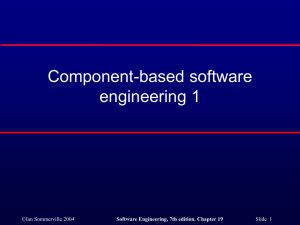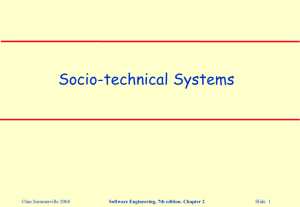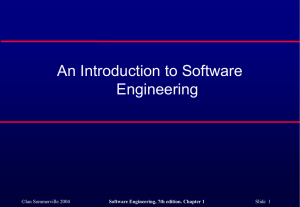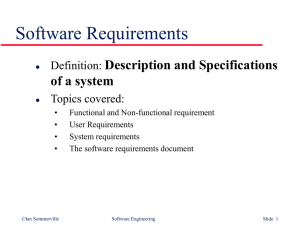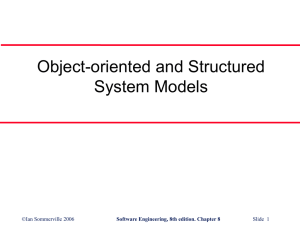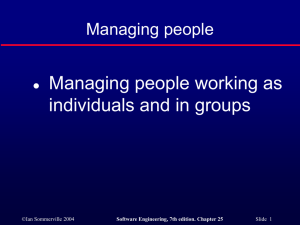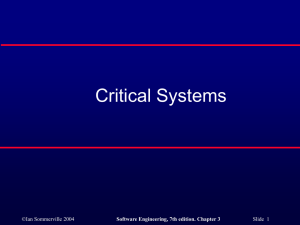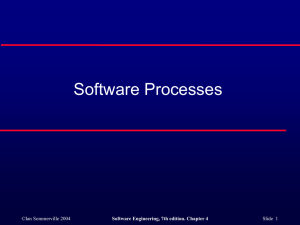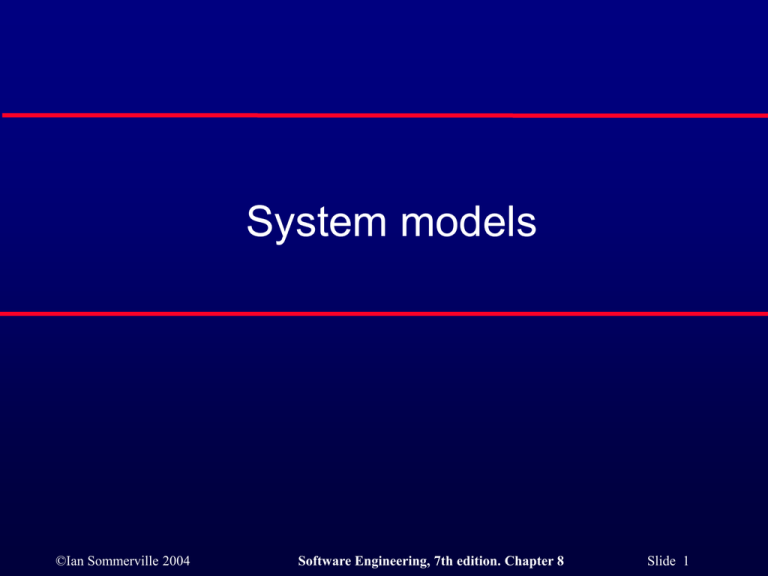
System models
©Ian Sommerville 2004
Software Engineering, 7th edition. Chapter 8
Slide 1
Objectives
To explain why the context of a system
should be modelled as part of the RE
process
To describe behavioural modelling, data
modelling and object modelling
To introduce some of the notations used in
the Unified Modeling Language (UML)
To show how CASE workbenches support
system modelling
©Ian Sommerville 2004
Software Engineering, 7th edition. Chapter 8
Slide 2
Topics covered
Context models
Behavioural models
Data models
Object models
CASE workbenches
©Ian Sommerville 2004
Software Engineering, 7th edition. Chapter 8
Slide 3
System modelling
System modelling helps the analyst to understand
the functionality of the system and models are used
to communicate with customers.
Different models present the system from different
perspectives
•
•
•
External perspective showing the system’s context or
environment;
Behavioural perspective showing the behaviour of the
system;
Structural perspective showing the system or data
architecture.
©Ian Sommerville 2004
Software Engineering, 7th edition. Chapter 8
Slide 4
Model types
Data processing model showing how the data is
processed at different stages.
Composition model showing how entities are
composed of other entities.
Architectural model showing principal sub-systems.
Classification model showing how entities have
common characteristics.
Stimulus/response model showing the system’s
reaction to events.
©Ian Sommerville 2004
Software Engineering, 7th edition. Chapter 8
Slide 5
Context models
Context models are used to illustrate the
operational context of a system - they show
what lies outside the system boundaries.
Social and organisational concerns may
affect the decision on where to position
system boundaries.
Architectural models show the system and its
relationship with other systems.
©Ian Sommerville 2004
Software Engineering, 7th edition. Chapter 8
Slide 6
The context of an ATM system
Securit y
system
Br anch
Account
account ing
system
da t abase
Aut o- te lle r
system
Br anch
Usa ge
dat abase
counte r
system
Maint enance
system
©Ian Sommerville 2004
Software Engineering, 7th edition. Chapter 8
Slide 7
Process models
Process models show the overall process
and the processes that are supported by the
system.
Data flow models may be used to show the
processes and the flow of information from
one process to another.
©Ian Sommerville 2004
Software Engineering, 7th edition. Chapter 8
Slide 8
Equipment procurement process
©Ian Sommerville 2004
Software Engineering, 7th edition. Chapter 8
Slide 9
Behavioural models
Behavioural models are used to describe the
overall behaviour of a system.
Two types of behavioural model are:
•
•
Data processing models that show how data is
processed as it moves through the system;
State machine models that show the systems
response to events.
These models show different perspectives so
both of them are required to describe the
system’s behaviour.
©Ian Sommerville 2004
Software Engineering, 7th edition. Chapter 8
Slide 10
Data-processing models
Data flow diagrams (DFDs) may be used to
model the system’s data processing.
These show the processing steps as data
flows through a system.
DFDs are an intrinsic part of many analysis
methods.
Simple and intuitive notation that customers
can understand.
Show end-to-end processing of data.
©Ian Sommerville 2004
Software Engineering, 7th edition. Chapter 8
Slide 11
Order processing DFD
©Ian Sommerville 2004
Software Engineering, 7th edition. Chapter 8
Slide 12
Data flow diagrams
DFDs model the system from a functional
perspective.
Tracking and documenting how the data
associated with a process is helpful to
develop an overall understanding of the
system.
Data flow diagrams may also be used in
showing the data exchange between a
system and other systems in its environment.
©Ian Sommerville 2004
Software Engineering, 7th edition. Chapter 8
Slide 13
Insulin pump DFD
©Ian Sommerville 2004
Software Engineering, 7th edition. Chapter 8
Slide 14
State machine models
These model the behaviour of the system in
response to external and internal events.
They show the system’s responses to stimuli so are
often used for modelling real-time systems.
State machine models show system states as nodes
and events as arcs between these nodes. When an
event occurs, the system moves from one state to
another.
Statecharts are an integral part of the UML and are
used to represent state machine models.
©Ian Sommerville 2004
Software Engineering, 7th edition. Chapter 8
Slide 15
Statecharts
Allow the decomposition of a model into submodels (see following slide).
A brief description of the actions is included
following the ‘do’ in each state.
Can be complemented by tables describing
the states and the stimuli.
©Ian Sommerville 2004
Software Engineering, 7th edition. Chapter 8
Slide 16
Microwave oven model
©Ian Sommerville 2004
Software Engineering, 7th edition. Chapter 8
Slide 17
Microwave oven state description
S tat e
D escr iption
W ai tin g
T h e o v en i s wa iting for in pu t. The di sp la y sh ows th e c urre nt t im e .
H al f p ow er
T h e o v en p ow er is s et t o 3 00 w at ts. T h e d is play s ho w s ÔHal f p ow erÕ.
F ull p ow er
T h e o v en p ow er is s et t o 6 00 w at ts. T h e d is play s ho w s ÔFull p ow erÕ.
S et time
T h e co ok in g tim e is s et to th e us erÕs inp ut v al u e. T h e d isp la y shows th e co ok in g tim e
select e d an d is u pd at e d as th e t im e is s et .
D isab le d
O ve n o pe rat ion is dis ab led fo r saf e ty . Inter ior o ve n lig h t is o n. D is play sh ows ÔNot
rea d yÕ.
E n ab led
O ve n o pe rat ion i s en a bled. In te ri or ov en l igh t is off . D isp la y s how s ÔR ea d y to co o kÕ.
O pe ratio n
O ve n in o pe ratio n. In te rio r ov en li g ht is on . D isp la y shows th e tim er co un td ow n. O n
com ple tio n of co ok in g, th e b uzz e r is so un de d for 5 s ec o nds . O ve n lig h t is o n. D is play
shows ÔC oo king com pl e te Õ while b uz ze r i s so un ding .
©Ian Sommerville 2004
Software Engineering, 7th edition. Chapter 8
Slide 18
Microwave oven stimuli
S tim u lus
D escr iption
H al f p ow er
T h e u se r ha s pr essed th e h alf pow er bu tto n
F ull p ow er
T h e u se r ha s pr essed th e full p ow er b u tton
Ti me r
T h e u se r ha s pr essed on e o f the tim er bu tto ns
N umb er
T h e u se r ha s pr essed a n um eric ke y
D oo r op en
T h e o v en d o or sw itch is n ot clos ed
D oo r cl os ed
T h e o v en d o or sw itch is closed
S tart
T h e u se r ha s pr essed th e sta rt bu tton
C a nce l
T h e u se r ha s pr essed th e ca n ce l b u tton
©Ian Sommerville 2004
Software Engineering, 7th edition. Chapter 8
Slide 19
Microwave oven operation
©Ian Sommerville 2004
Software Engineering, 7th edition. Chapter 8
Slide 20
Semantic data models
Used to describe the logical structure of data
processed by the system.
An entity-relation-attribute model sets out the
entities in the system, the relationships between
these entities and the entity attributes
Widely used in database design. Can readily be
implemented using relational databases.
No specific notation provided in the UML but objects
and associations can be used.
©Ian Sommerville 2004
Software Engineering, 7th edition. Chapter 8
Slide 21
Library semantic model
©Ian Sommerville 2004
Software Engineering, 7th edition. Chapter 8
Slide 22
Data dictionaries
Data dictionaries are lists of all of the names used in
the system models. Descriptions of the entities,
relationships and attributes are also included.
Advantages
•
•
Support name management and avoid duplication;
Store of organisational knowledge linking analysis, design
and implementation;
Many CASE workbenches support data dictionaries.
©Ian Sommerville 2004
Software Engineering, 7th edition. Chapter 8
Slide 23
Data dictionary entries
N ame
D escr iption
T yp e
D ate
A rtic le
D eta ils of th e p ub li sh ed artic le tha t m ay b e ord ered b y
p eo p le usin g LI B SYS .
E n tity
3 0. 1 2.20 02
au th ors
T h e nam es of the au tho rs of th e a rtic le w ho m ay be du e
a sh are o f th e f ee.
A ttrib ute
3 0. 1 2.20 02
B u ye r
T h e pe rso n or org an is at ion th at orde rs a co p y of the
article .
E n tity
3 0. 1 2.20 02
A 1:1 re lat ions hip b et w ee n A rtic le an d th e C o pyr ig h t
A ge n cy w h o s ho ul d b e p ai d th e c op yrig ht fe e.
R e la tio n
2 9. 1 2.20 02
T h e ad dress o f th e bu ye r. Th is is used to an y pa p er
b il lin g inform at ion t ha t is r eq uire d.
A ttrib ute
3 1. 1 2.20 02
fee p aya b le -t o
A dd re ss
(B u ye r)
©Ian Sommerville 2004
Software Engineering, 7th edition. Chapter 8
Slide 24
Object models
Object models describe the system in terms of
object classes and their associations.
An object class is an abstraction over a set of
objects with common attributes and the services
(operations) provided by each object.
Various object models may be produced
•
•
•
Inheritance models;
Aggregation models;
Interaction models.
©Ian Sommerville 2004
Software Engineering, 7th edition. Chapter 8
Slide 25
Object models
Natural ways of reflecting the real-world
entities manipulated by the system
More abstract entities are more difficult to
model using this approach
Object class identification is recognised as a
difficult process requiring a deep
understanding of the application domain
Object classes reflecting domain entities are
reusable across systems
©Ian Sommerville 2004
Software Engineering, 7th edition. Chapter 8
Slide 26
Inheritance models
Organise the domain object classes into a hierarchy.
Classes at the top of the hierarchy reflect the
common features of all classes.
Object classes inherit their attributes and services
from one or more super-classes. these may then be
specialised as necessary.
Class hierarchy design can be a difficult process if
duplication in different branches is to be avoided.
©Ian Sommerville 2004
Software Engineering, 7th edition. Chapter 8
Slide 27
Object models and the UML
The UML is a standard representation devised by
the developers of widely used object-oriented
analysis and design methods.
It has become an effective standard for objectoriented modelling.
Notation
•
•
•
Object classes are rectangles with the name at the top,
attributes in the middle section and operations in the
bottom section;
Relationships between object classes (known as
associations) are shown as lines linking objects;
Inheritance is referred to as generalisation and is shown
‘upwards’ rather than ‘downwards’ in a hierarchy.
©Ian Sommerville 2004
Software Engineering, 7th edition. Chapter 8
Slide 28
Library class hierarchy
Libr ar y it em
Ca t alo gue n um ber
Acquisition da t e
Cost
Type
St a t us
Num ber of
copie s
Acquir e ( )
Ca t alo gue ( )
Dispose ()
I ssue ()
Ret urn ( )
Pub lished it em
Recor ded it em
Title
Medium
Title
Pub lisher
Book
Aut hor
Edit ion
Pub lica t ion da t e
Ma gazine
Year
I ssue
Film
Com puter
pr o gr am
Dir ect or
Da t e of r elease
Dist rib ut or
Ver sion
Pla t for m
ISB N
©Ian Sommerville 2004
Software Engineering, 7th edition. Chapter 8
Slide 29
User class hierarchy
Libr ar y user
Nam e
Addr ess
Ph o n e
Reg ist r a t io n #
Reg ist er ( )
De- r eg ist er ( )
Reade r
Bo r r o w er
I tem s o n loa n
Max . lo an s
Aff ilia t io n
St af f
Dep ar t men t
Dep ar t men t ph o n e
©Ian Sommerville 2004
St uden t
Majo r subjec t
Ho me ad dr ess
Software Engineering, 7th edition. Chapter 8
Slide 30
Multiple inheritance
Rather than inheriting the attributes and services
from a single parent class, a system which supports
multiple inheritance allows object classes to inherit
from several super-classes.
This can lead to semantic conflicts where
attributes/services with the same name in different
super-classes have different semantics.
Multiple inheritance makes class hierarchy
reorganisation more complex.
©Ian Sommerville 2004
Software Engineering, 7th edition. Chapter 8
Slide 31
Multiple inheritance
Book
Voice r ecording
Aut hor
Edit ion
Pub lica t ion da t e
I SB N
Speak er
Dur a t ion
Recor ding da t e
Talking book
# Ta pes
©Ian Sommerville 2004
Software Engineering, 7th edition. Chapter 8
Slide 32
Object aggregation
An aggregation model shows how classes
that are collections are composed of other
classes.
Aggregation models are similar to the part-of
relationship in semantic data models.
©Ian Sommerville 2004
Software Engineering, 7th edition. Chapter 8
Slide 33
Object aggregation
©Ian Sommerville 2004
Software Engineering, 7th edition. Chapter 8
Slide 34
Object behaviour modelling
A behavioural model shows the interactions
between objects to produce some particular
system behaviour that is specified as a usecase.
Sequence diagrams (or collaboration
diagrams) in the UML are used to model
interaction between objects.
©Ian Sommerville 2004
Software Engineering, 7th edition. Chapter 8
Slide 35
Issue of electronic items
©Ian Sommerville 2004
Software Engineering, 7th edition. Chapter 8
Slide 36
Structured methods
Structured methods incorporate system
modelling as an inherent part of the method.
Methods define a set of models, a process
for deriving these models and rules and
guidelines that should apply to the models.
CASE tools support system modelling as
part of a structured method.
©Ian Sommerville 2004
Software Engineering, 7th edition. Chapter 8
Slide 37
Method weaknesses
They do not model non-functional system
requirements.
They do not usually include information
about whether a method is appropriate for a
given problem.
The may produce too much documentation.
The system models are sometimes too
detailed and difficult for users to understand.
©Ian Sommerville 2004
Software Engineering, 7th edition. Chapter 8
Slide 38
CASE workbenches
A coherent set of tools that is designed to
support related software process activities
such as analysis, design or testing.
Analysis and design workbenches support
system modelling during both requirements
engineering and system design.
These workbenches may support a specific
design method or may provide support for a
creating several different types of system
model.
©Ian Sommerville 2004
Software Engineering, 7th edition. Chapter 8
Slide 39
An analysis and design workbench
Da t a
dict ionar y
Code
gener
ator
Fo r m s
cr ea tion
t ools
©Ian Sommerville 2004
St ruc tur ed
Repor t
dia g ram m ing
gener a t ion
t ools
f acilities
Ce nt r al
Quer y
info r m a t ion
langua ge
r eposit or y
f acilities
Design, anal
ysis
and checking
t ools
I mpor t /e xpor t
f acilities
Software Engineering, 7th edition. Chapter 8
Slide 40
Analysis workbench components
Diagram editors
Model analysis and checking tools
Repository and associated query language
Data dictionary
Report definition and generation tools
Forms definition tools
Import/export translators
Code generation tools
©Ian Sommerville 2004
Software Engineering, 7th edition. Chapter 8
Slide 41
Key points
A model is an abstract system view.
Complementary types of model provide
different system information.
Context models show the position of a
system in its environment with other systems
and processes.
Data flow models may be used to model the
data processing in a system.
State machine models model the system’s
behaviour in response to internal or external
events
©Ian Sommerville 2004
Software Engineering, 7th edition. Chapter 8
Slide 42
Key points
Semantic data models describe the logical
structure of data which is imported to or
exported by the systems.
Object models describe logical system
entities, their classification and aggregation.
Sequence models show the interactions
between actors and the system objects that
they use.
Structured methods provide a framework for
developing system models.
©Ian Sommerville 2004
Software Engineering, 7th edition. Chapter 8
Slide 43


